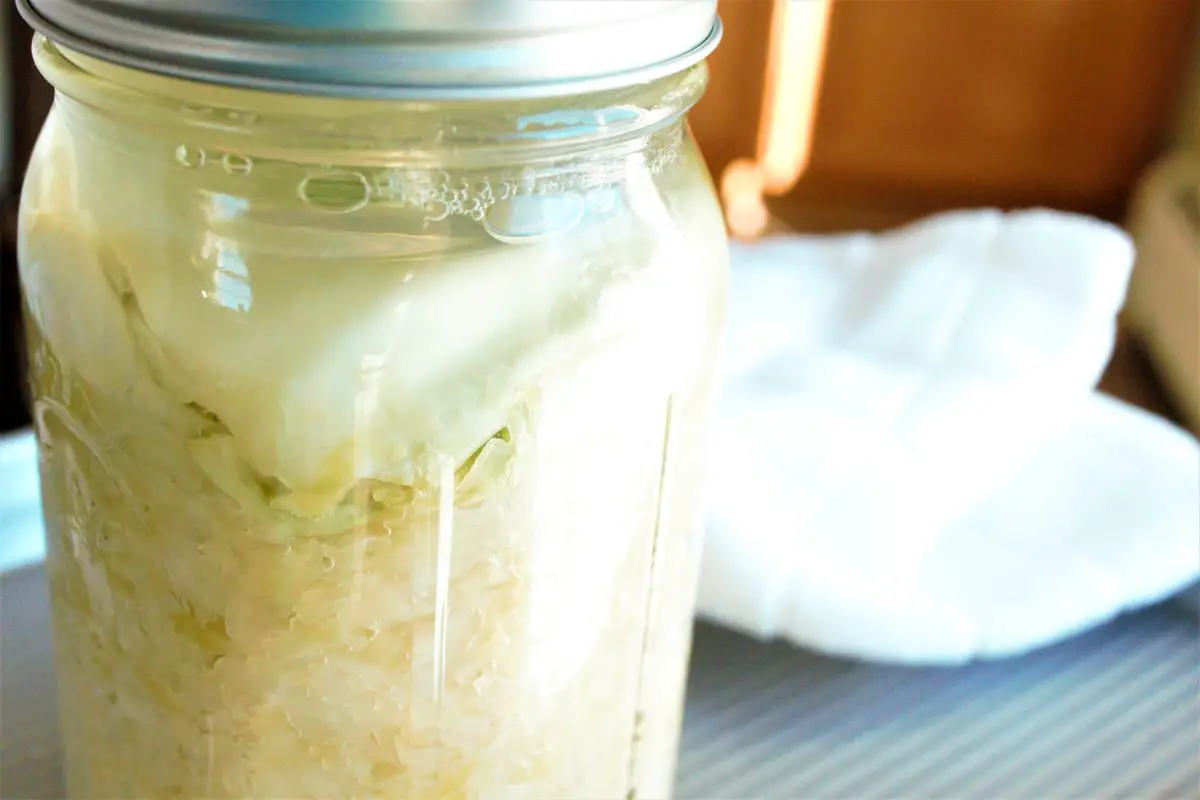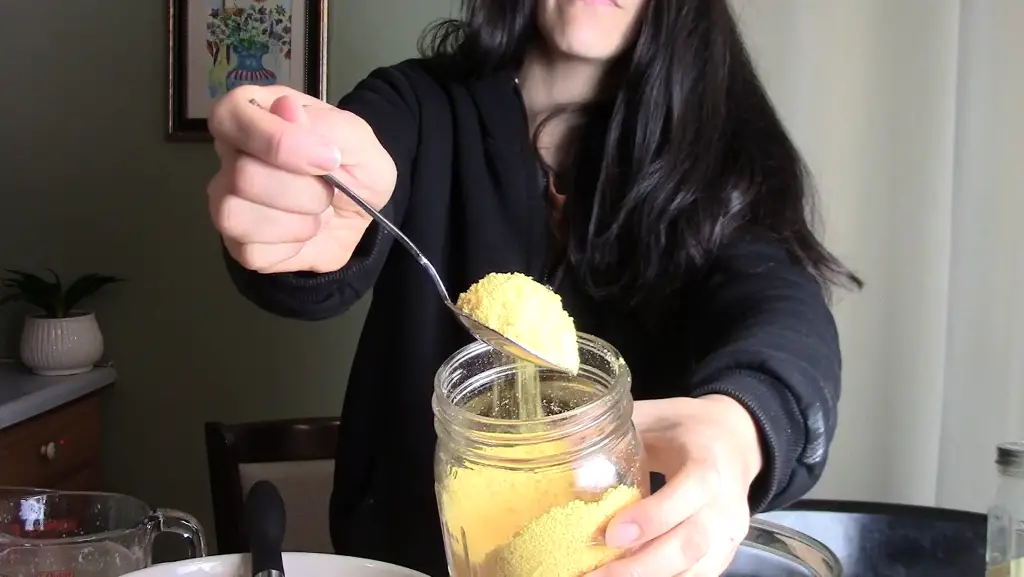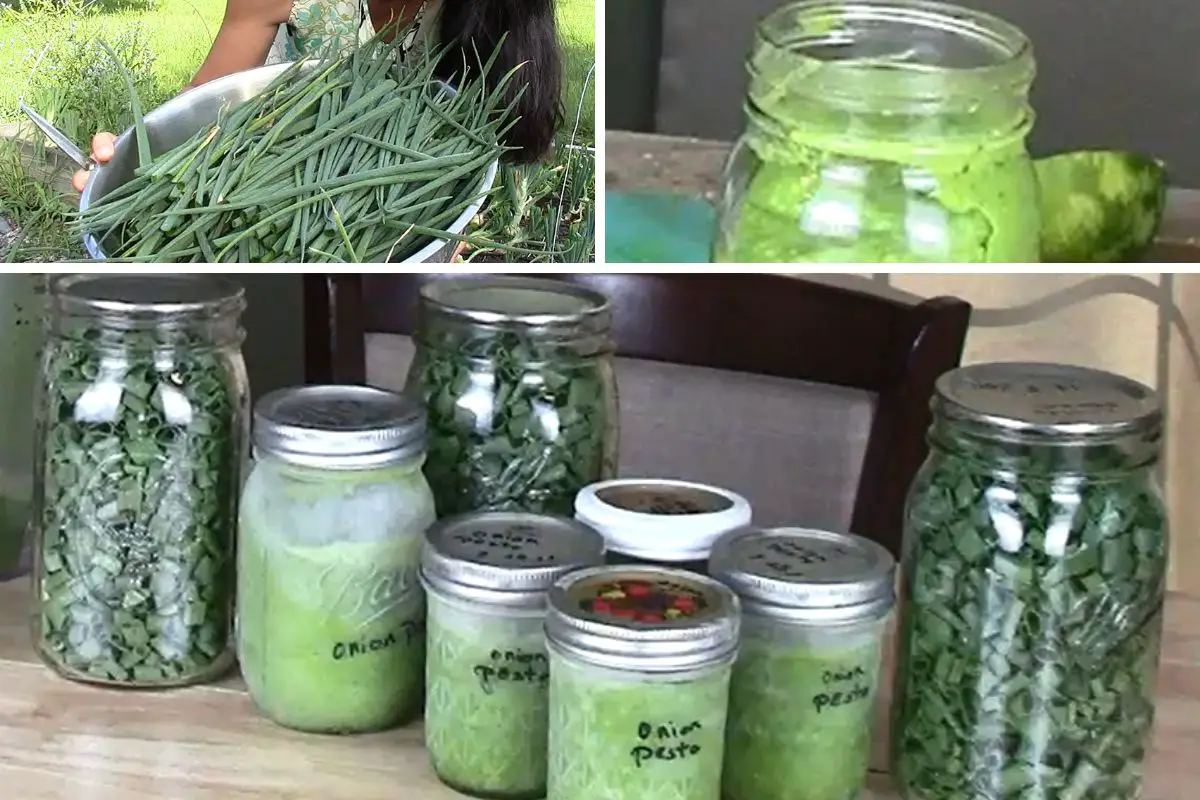Sauerkraut is a lacto-fermented food that is full in probiotics. It’s good for your health, and it’s delicious as a side. How do you make sauerkraut? All you need is some cabbage, salt, your hands, and something to put the sauerkraut in.
Jump to RecipeUTENSILS NEEDED FOR MAKING SAUERKRAUT
- Large bowl
- Pounder, for packing the sauerkraut into the jar
- Jar or crock with a lid
- Glass weight
- Cutting board
- Sharp knife
- Kitchen scale
WHAT IS LACTO-FERMENTATION
Lacto fermentation is the process of preserving food by using lactic acid. This process occurs when lactic-acid producing bacteria consumes the sugars in the food, and in return produces lactic acid and carbon dioxide.
A non iodized salt is added into a lacto-fermentation process to prevent the bad bacteria from growing. Lacto-fermented food is usually submerged in a salt water brine. However, in the case of sauerkraut, all you need is cabbage and kosher salt, or non iodized salt.
Three things need to happen for a good lacto-fermentation process to occur. The food needs to be submerged under a brine creating a low oxygen environment, salt is added, and lactic acid is being produced.
The highly acidic, high in salt, and low oxygen environment is a great place for good bacteria to reproduce, and a very bad place for harmful bacteria. Which is exactly what we want.
THE PROCESS OF MAKING SAUERKRAUT
How to Slice The Cabbage
Slicing the cabbage is really a preference thing. It is ultimately up to you, and how you like your sauerkraut to be. Whether you like it thick or ultra thin, they both work.
I have seen some people who would submerge the whole head of cabbage in a salt brine. Without the thick stem of course.
I have also seen some people remove the stem and fill that whole area with salt. The point is, it’s a whole head of cabbage that is being turned into sauerkraut, all at once.
Now I myself, have not tried these methods yet, but I did ferment big slices of cabbage in making Kimchi, numerous times.
So feel free to slice them thick or thin. Just think about what texture you would like, and how big of a slice you’d want when you get the sauerkraut out of the jar.
What Type of Salt is Used in Making Sauerkraut
The most important thing to note is that you cannot make sauerkraut, or any fermented food for that matter, using regular table salt.
Table salt usually has iodine in it. Iodine will cause the food to deteriorate quickly. There has been recent studies that showed that Iodized salt does not inhibit or interfere in the fermentation process. However, my experience says otherwise.
Even though I did not ferment food using Iodized salt, I did pickle food using iodized salt. My experience in that is that the pickled food did not last for more than two weeks. The food began to rot, and fall apart.
My suggestion to you, is go with what is known and has been long practiced, unless you are trying to do an experiment.
Use salt such as kosher salt, Himalayan pink salt, sea salt, or any salt that does not contain iodine in it.
Here is something to think about. If iodine did not affect fermented or canned food, then why do non of the big food canning companies use it?
Perhaps it’s true that it does not affect the fermentation process, but maybe it does have a different effect such as causing the food to rot quickly. Should I do an experiment on this? Maybe…

How Wilting the Cabbage Affects your Sauerkraut
Traditionally, the cabbage is salted, and pounded after it has been sliced. The pounding process causes the cabbage to wilt and release its juices.
However, taking it from the kimchi experts, Korean people have been long making kimchi without pounding it. So what’s the secret?
It really is no secret that salt causes food to release their juices, and causes them to be crispy. So how do you get wilted cabbage without pounding it.
It’s simple. Simply sprinkle the sliced cabbage with salt, and mix it all together. You can give it a few squishes with your hand if you want.
Let it sit for 30 minutes. Then 30 minutes later, mix it again and squish it a few times using your hands. Do this step every 30 minutes for the period of 2 hours.
By the end of the 2 hours, or even longer if you want, the cabbage is fully wilted and has released its juices. No pounding is required. Now you can transfer the newly made sauerkraut into a clean glass jar, or a crock.
Why is Wilting the Cabbage Important
When the cabbage is not wilted and is immediately staked into a glass jar or a crock, the cabbage will have tons of air pockets in between.
We discussed earlier how one of the most important factors other than salt in making fermented food was the lack of oxygen.
Lots of air pockets means lots of oxygen. Lots of oxygen means a good environment for bad bacteria to grow. Don’t be surprised if you found mold and maybe other things in there when you did not wilt your sauerkraut.
The wilting process causes the cabbage to take whatever form you give it. It causes them to lay flat against each other without any resistance. And it also causes lots of brine to occur.
This brine is added to the sauerkraut after it has been pushed down into the jar as hard as possible.
The brine will fill in any empty spaces, and prevent oxygen bubbles from occurring. You can also push down on the sauerkraut after adding the brine to ensure that there are no air bubbles.
A cabbage leaf, or a weight is then placed, or both, is then placed over the surface of the sauerkraut to prevent little pieces from floating to the surface.
Anything that floats to the surface and comes in touch with air will introduce bad bacteria.
HOW LONG SHOULD I LET MY SAUERKRAUT FERMENT FOR
Sauerkraut generally needs about 5 to 10 days to ferment, depending on the room temperature that it’s in.
In a hot environment, it can ferment as quickly as 3 days.
They way to tell if your sauerkraut is fermented is by smelling it. If it smells sour, then it’s good to go. Also if you see bubbles rising to the surface, that’s the beginning of the fermentation process.
Sauerkraut is going to continue to ferment as long as there is enough sugar for the bacteria to feed on.
The more sour you like your sauerkraut to be, the longer you can allow it to ferment. Just be sure to place something under the jar or crock to catch all the juices that would run out during the fermentation process.
Once you are satisfied with the flavor of your sauerkraut, you can then place it in your fridge, or in a cold place.
The cold is going to slow down the fermentation process drastically. This will ensure that you can have your sauerkraut for a long time.
HOW TO USE SAUERKRAUT
You can use sauerkraut as a side dish to almost anything. Just add a little bit of sauerkraut on the side for some good probiotics.
You can also use sauerkraut to coo with. A lot of Dutch originating dishes have sauerkraut in them, and many of those dishes are delicious.
You can use sauerkraut over hot dogs, burgers, and sloppy joes, and whatever your heart desires.
LOOKING FOR MORE RECIPES? GIVE THESE A TRY!
Gluten Free Sourdough Bread Rolls
The Fluffiest Gluten Free Sourdough Pancakes
Interested in these?…
How To Make Freeze Dried Strawberries

Sauerkraut
Equipment
- Large bowl
- Pounder to Pack the Sauerkraut into the jar
- Glass jar or crock
- Glass Weight
- Cutting board
- Knife
- Kitchen scale
Ingredients
- 2 pounds Cabbage
- 20 g or 2 teaspoons Kosher salt You can add a little more of you desire
Instructions
- Reserve two cabbage leaves from the top leaves. Slice the cabbage to the desired thickness. Make sure to remove the stalk. Measure the sliced cabbage over a kitchen scale to ensure that it's 2 pounds.
- Place the sliced cabbage into a large bowl and sprinkle with the 20 grams of salt. Mix it all together and allow it to sit for 30 minutes.
- After the 30 minutes have passed, mix the cabbage again, give it a few squishes between your hands, and let it sit for another 30 minutes. Repeat this step twice more, or for the period of 2 hours. Or until the cabbage is fully wilted, and has decreased in volume by at least twice the amount, and lots of brine has been formed during this process.
- Place the wilted cabbage into a clean glass jar or a crock and press down on it using a pounder to remove any air bubbles.
- Fill the jar with the brine that was made during the wilting process. Press down on the sauerkraut again using the pounder. Cover with the two cabbage leaves, and press down again.
- Place the glass weight over the cabbage leaves and sauerkraut. Place a lid over the jar, but do not tighten it. The sauerkraut will release carbon dioxide in the jar during the fermentation process. If you leave the lid too tight, the jar can explode., or shatter. Just place the lid over it and give it a gentle twist without tightening it. You might need to slightly release the lid again after a couple days or so.
- Allow the sauerkraut to ferment over the counter for 5 to 10 days or until it begins to bubble up, and smell slightly sour. If you like your sauerkraut to be more sour, you can allow it to ferment for a bit longer.
- Once the sauerkraut has fermented to your desired taste, place it into the fridge, or in a cold environment to slow down the fermentation process. The fermentation process never really stops, but you can slow it down drastically by placing it in a cold environment.




Be the first to reply